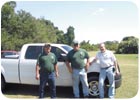
Randy Bryan, SB Drilling's equipment manager, Steve Bryan and Tim Miller, special projects manager.
A snapshot of Steve Bryan's philosophy on life: “You are who you associate yourself with. If you want to be a millionaire, hang around a millionaire; if you want to be a bum, hang around a bum.” After meeting him, it quickly becomes apparent that Bryan, president of SB Drilling, wants to be a successful geotechnical drilling contractor. “We're in our fourth year now,” Bryan says. “I started the business on a wing and a prayer - and a credit card.”

The gate to the property is well guarded.
The company's first project was dewatering a landfill for a company called CDM. “They asked me if I could do it and I said, 'Sure I can,'” Bryan recounts. “I didn't have a drill rig, but they didn't ask if I had a drill rig; they asked if I could do it. Carlos had an old Buck Rogers 160 trailer-mounted rig and an F-600 flatbed pick-up truck, and I bought those two pieces of equipment from him. Getting around on that landfill was impossible, so I went out and purchased a four-wheel-drive truck to put the rig on. I'd do the drilling and then bring the rig back and every day I'd add a piece here and add a piece there until finally - after about three months - I got the whole thing put together. I worked it by myself for around eight months; CDM was supposed to supply me with a helper, but that didn't work out. I got CDM to give me a little bit more money so I could hire someone to help me. For a while, I just went to the day labor pool to get someone.”
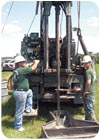
Ron Moore and his apprentice use the CME 75 used to install 3-inch casing for geophysical logging.
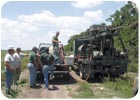
Loading up water.
The Turning Point
“The big turnaround point for SB Drilling happened when the big cross-town expressway project in Tampa failed,” explains Bryan. “It was decided that the whole project would be re-drilled. We were asked to go in and do some coring. That meant another leap - we purchased a CME 75 and a core barrel and that got us into the bigger, deeper geo-technical-type drilling. We worked on that project for about seven months.” That job let Bryan know that SB Drilling had arrived. He started out with one trailer-mounted rig and in two years, was running four rigs. Today, the company boasts five rigs and 13 employees.“My background is in real heavy drilling - from geotech up to municipal - and oil and gas; I spent 10 years in the oil fields,” Bryan explains. “I treated it all as if I was going to school. I took cuts in pay to go to work for certain people just to learn what they did. I learned environmental and geotechnical drilling, then went to domestic-type wells, which led to public supply, then municipal supply and deep agricultural. I did the whole gamut - everything from a 2-inch monitoring well 10 feet deep to a 24-inch municipal supply well 1,500 feet deep.” A well-rounded education, indeed.
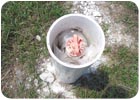
One of the 32 piezometers that SB Drilling installed.
Business Plan
“I've been talking with Carlos about SB Drilling's future,” Bryan reveals. “We're looking at how we can double our revenues in two years. We're looking at taking on two more bigger rigs - maybe another 75 or an 85 or 95, something like that - and going after a lot of the Army Corps of Engineers-type work, specializing in coring and wire lines and packer testing. We'd like to get into water resources, but I don't think we're quite ready for that right now. It's such a big investment; you're talking about having to spend a million dollars just to get into it. You need a big enough rig to do it and then you have to try to staff it. It's hard enough to get a qualified geo-technical driller, let alone someone who can handle a 24-inch well going down 1,000 feet.” Qualified drillers looking to do quality work on quality projects can telephone 866-DRILLER.“One of the main reasons we've been profitable each and every year is we've been frugal,” Bryan explains. “We haven't gone out and spent $300,000 on a drill rig. We've taken equipment that was so-so and went in and maintained it and worked on it and retrofitted it so it would get the work done. In some cases, the older equipment is better for us because of the hydraulics - there's no electrical tied into it. You can work on a regular handle valve; a micro-mini-switch will have you ripping out your hair.”
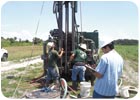
In the foreground is a representative for the client, collecting data as it comes out of the ground.
Everglades Restoration
The project SB Drilling was working on during my visit is part of the Comprehensive Everglades Restoration Project (CERP). The plan provides a framework and guide to restore, protect and preserve the water resources of central and southern Florida, including the Everglades - it covers an 18,000-square-mile area. CERP will take more than 30 years to construct and will cost an estimated $7.8 billion. The goal is to capture fresh water that now flows unused to the ocean and the gulf, and redirect it to areas that need it most. The majority of the water will be devoted to environmental restoration, reviving a dying ecosystem. The remaining water will benefit cities and farmers by enhancing water supplies for the south Florida economy.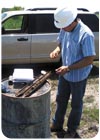
Examining the samples.
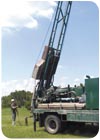
Going down 150 feet to collect lithology samples.
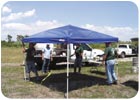
A tent provides relief from the oppressive Florida sun.
Phase two of CERP will involve more of the same - more piezometers, more monitoring wells, probably at deeper depths.
Asked for a timetable on SB Drilling's involvement in the project, Bryan says, “Who knows? We could be out there for the next three or four years, depending on how long it takes to build this thing.” What we do know is that this project will represent an honors course in Steve Bryans's college of drilling knowledge.
ND
Report Abusive Comment